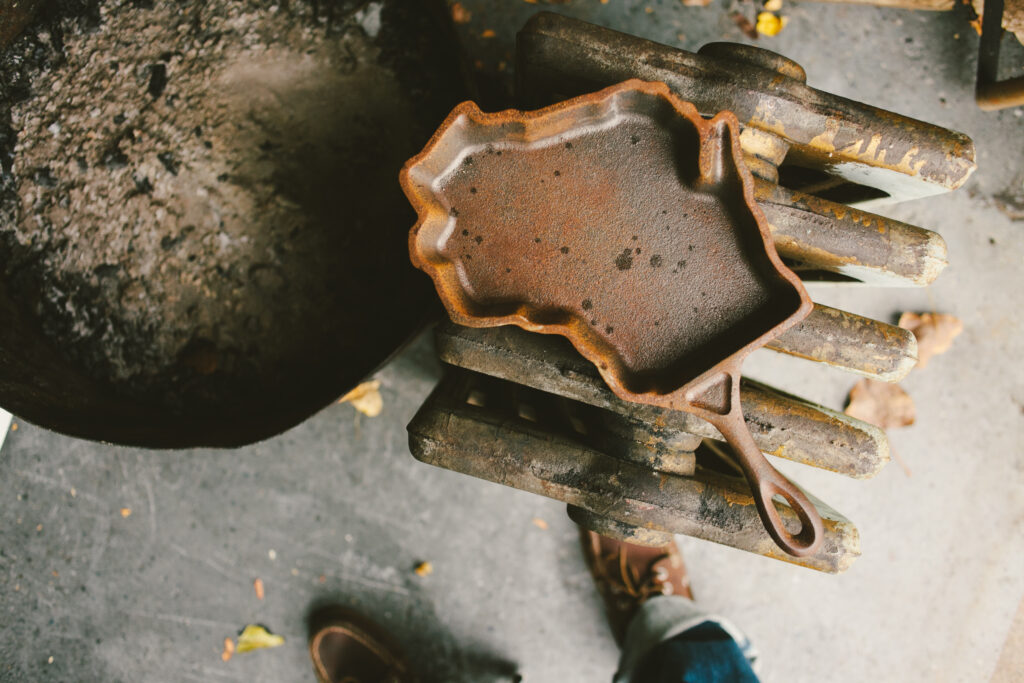Seasoned Cast Iron Cookware
Seasoning Your Skillet
Seasoning a skillet is no flash in the pan, and it also has nothing to do with adding salts or spices or flavoring your skillets. What we are actually doing is creating a naturally protective non-stick layer to the skillet's surface using organic flax seed oil and high heat, turning the once fluid oil into a baked-on coat of dry and smooth cooking surface.
This transition of oil turning into a thin non stick layer onto your skillet is called "polymerization", and it's a process that takes 8-12 hours to successfully achieve the end result of a coveted matte black finish, similar to that of a well used skillet. If you have a gunky old pan, or just want to brush up the seasoning layer on your relatively clean skillet, these are the steps to follow for getting a wonderfully coated and seasoned cast iron skillet

If you are starting this process right after using it to cook on, simply wipe and wash your pan with warm water and a wee bit of soap to start. If you have an extremely rusty or gunky older pan, you'll need to first clean it thoroughly with a metal scrubby, wire wheel, detergent or possibly the e-tank method if you want a completely perfect raw pan to start with, which is the goal. Dry the clean pan thoroughly over a flame or in the oven at 200 degrees to make sure it’s bone dry. This also helps to open up the pores of the iron in preparation for accepting the oil and developing a good hard seasoning.
Drizzle a little flax seed oil into the warm dry pan and use a brush or paper towel to spread it around everywhere on the pan, inside and out, - don’t forget the handle too! After you get oil into all the nooks and cranny’s, wipe it ALL OFF with a new towel or cotton cloth until it looks dry again. The micro layer of oil is all you need on each layer of oil. Too much oil will cause it to puddle or run, and will create a giant, hard to clean off blemish on the pan. Aim for even, micro thin coats of oil.
Put your pan upside down into the oven, turn the oven up to its highest baking temperature ( 450-500 degrees F), and allow the cold pan to preheat with the oven.
Set the timer for 1 hour and turn on your kitchen fan. While the pan starts to hit the critical temperature for polymerization (this temp. varies depending on the oil you are using), it will start to smoke and can fill your kitchen up fast if you don't provide some ventilation. This smoke *IS* the seasoning process, so stay calm and open some windows!
After the first hour, stop the oven and let the pan cool without opening the door (approximately 2 hours). If you peak into the oven, you'll probably notice right away that your pan is several shades darker, or sometimes it moves through a bronzy-red-brown color in it's first few coats, before it reaches the deep black that we're going after here.
Repeat the processes from Step 2-4 again for a total of 6 times – yes, 6 TIMES ! This is the most ideal way to insure your pan will have the most even and hardest seasoning you’ve ever seen in an iron skillet! Once you're done, you're ready to start cooking !! Keep your skillet up by following Step 2 after each meal, and just a little heat over a flame until it smokes a bit, will be an excellent maintenance routine to get into.
Seasoning your Skillet the FeLion way
While there are many seasoning opinions, it’s essentially choosing an oil, getting heat above 450 degrees, and dedicating a weekend. Maintaining a seasoned skillet is simple: clean, dry, and occasionally re-oil after meals. Whether you’re a soap user or not, cast iron is forgiving; you can always re-season. It’s hard to truly ruin it, barring breaks or warping.
We can season your skillet, or you can try it yourself. Cast iron is a beautiful, healthy investment. We hope to be part of your culinary journey. May your seasoning be hot and enjoyable, setting you up for a lifetime of cast iron use!

